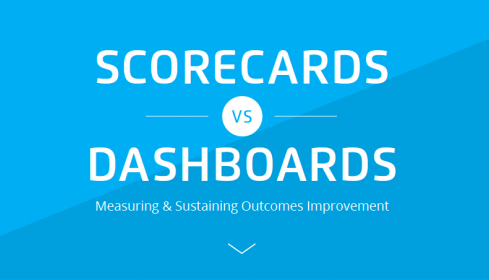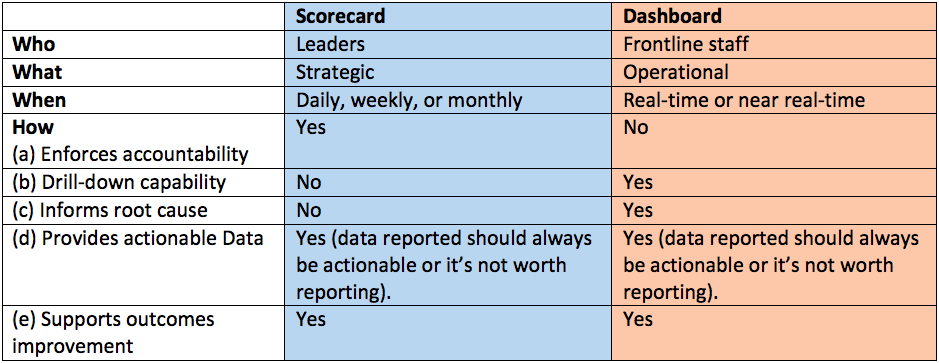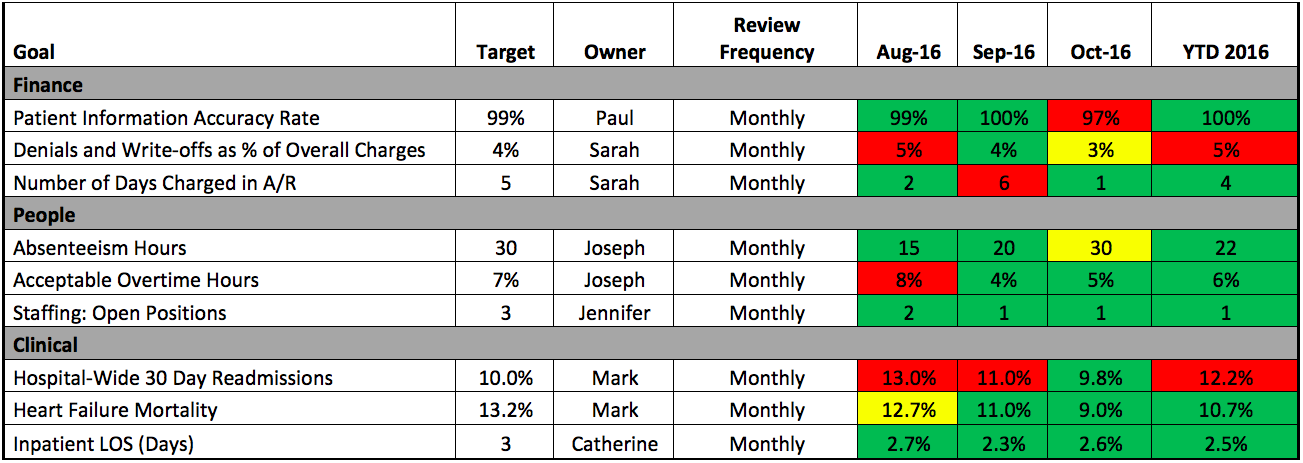Healthcare IT leaders tend to debate over which tool is best for measuring and sustaining outcomes improvement goals: healthcare dashboards or scorecards. But using both tools is the most effective approach.
“Scoreboards” take advantage of the high-level, strategic capacity of scorecards and the real-time, operational functionality of dashboards. But using both effectively requires a thorough understanding of the who, what, when, and how of each tool.
• Who: Scorecards are for leaders; dashboards are for the frontline.
• What: Scorecards are strategic; dashboards are operational.
• When: Scorecards are daily, weekly, or monthly reports; dashboards are real-time or near real-time.
• How: Scorecards enforce accountability and provide actionable data; dashboards provide drill-down capability and inform root cause.
Despite the different but equally important aspects of each tool, they best support outcomes improvement when used together.



Measuring and sustaining outcomes improvement in healthcare is a top priority for industry leaders. But when it comes to the best tools for the job, healthcare leaders find themselves in a scorecard-versus-dashboard debate. This blog settles the debate with the recommendation to use both.
Healthcare dashboards and scorecards used in tandem (sometimes referred to as “scoreboards”) is the best way to measure and sustain outcomes improvement—scoreboards marry a scorecard’s big picture overview with a dashboard’s capacity to drill down to the details.
Using scorecards and dashboards in tandem is critical for outcomes improvement, but knowing what they do, when to use them, how to use them, and who should use them is just as important. This blog provides a side-by-side comparison of scorecards and dashboards to ensure leaders use the right tool at the right time with the right people.

Scorecards provide a high-level, one-page overview of a health system’s long-term, strategic outcomes improvement goals (e.g., reduce readmissions, increase average patient satisfaction, and reduce average OR turnaround times).
Scorecards are long-term—slow to change as goals change over time (weeks, months, or years). They leverage an Enterprise Data Warehouse (EDW), which combines EMR, financial/billing, and patient satisfaction data, to track strategic goals. The data latency caused by daily or weekly goals is perfectly fine for the long-term strategic goals captured in a scorecard.
Scorecards are typically organized by clinical program or specialty and measure performance against these goals (e.g., on target, at risk, off target) using simple visualizations (e.g., raw numbers, arrows, and stoplights). Scorecards are web accessible, mobile-friendly (e.g., tablet, smartphone), and ever-present because they aren’t pushed or pulled reports.

Unlike their long-term, strategic scorecard counterparts, dashboards provide real-time or near real-time operational information encompassing tactical scenarios. Scorecards tell health systems how they’re doing overall; dashboards tell systems what’s happening now using interactive metrics with drill-down capabilities.
Dashboard visualizations are more in-depth (e.g., gauges, charts, and graphs), making them great tools for tracking AIMs that support systemwide outcomes improvement goals. They create connections directly to live systems and EDW data to enable comparisons of current and historical healthcare data and allow for daily, constant monitoring of items affecting AIMs (e.g., view today’s readmissions, view triage wait times, and view current OR turnaround time).

Even the most effective tools are useless without a solid understanding of their intended audience. Presenting a dashboard to a system’s executive leadership, for example, might result in a tactical drill-down more appropriate for the frontline staff responsible for day-to-day operations. Similarly, presenting a high-level scorecard to the frontline won’t provide them with the actionable data they need; nor will it enforce accountability.
Healthcare leaders use scorecards to enforce ownership and accountability by assigning key stakeholders to each strategic goal (leaders who have influence over employees and processes).
Front line staff (e.g., admissions staff, OR coordinators, and nurse managers) use dashboards to monitor their daily progress in achieving systemwide outcomes improvement goals. For example, a health system Director of Support Services uses a dashboard to monitor call volume, wait times, and reported issues so he can react immediately.
The best approach for measuring and sustaining outcomes improvement is pairing the long-term, big-picture nature of scorecards with the real-time, tactical capabilities of dashboards to enforce individual accountability and track performance at a timely cadence. But this two-pronged approach won’t work unless healthcare leaders truly understand the who, what, when, and how for each tool.
Leading Wisely is a new generation executive decision-support system with personalized watch-lists, configurable visualizations and customizable alerts and notifications; giving users data and foresight to deal with every-day and unexpected challenges.